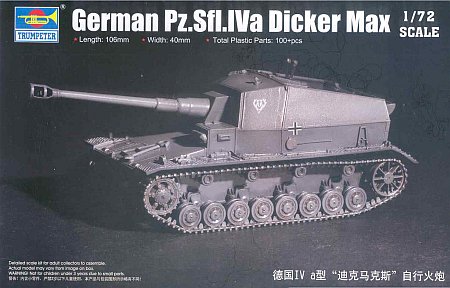|
This small-scale kit preview is of a German World War Two period 10.5cm Kanone L52 Selbstfahrlafette (self-propelled carriage) on the Panzer IV chassis,
known as the 10cm K. Pz.SflIVa, the Versuchsgeschuetz , or just the Dicker Max (Big Max). The vehicles original purpose was for a bunker buster against the French Maginot Line. The
two vehicles produced actually served primarily as a Panzerjaeger (tank destroyers) against Soviet forces in 1941 and 1942. Completed in late 1940 and early 1941 the Dicker Max was
built at the same time period as the Panzer IV Ausf.D and Ausf.E.
I was thrilled to see this rare vehicle released. I have long been enamored with open top panzerjägers. Before this I had only seen it in a crude resin wargaming model.
The Box Art: What is Supposed To Be Inside
Like many Trumpeter small scale models they put a photo of the completed model on the box cover, just like it is supposed to be built out of the box, no extra detailing. This is nice
for us as we see what the completed model is like, but can work against the manufacturer if the kit has obvious detail and accuracy issues.
Looking at the photo I am struck how odd it is that a significant part of the photo is in dark shadow. What is with that? What the shadow appears to be hiding is that the starboard
(right) side box on the glacis (what I understand to be a fake crew compartment with fake visor) is missing from the kit. Trumpeter appears to have forgotten it! I have seen photos of
both Dicker Max vehicles and they both had this starboard side box. More on this later.
Up on the superstructure we see the open top crew compartment similar to the Marder Panzerjägers and the Hummel SP howitzer. You will notice prominent horizontal and vertical ridges which
appear to be greatly exaggerated weld beads (you may want to sand these ridges down a bit). Protruding from the front is the impressively large 10.5cm gun with limited traverse and elevation
and large double-baffle muzzle break.
On the glacis we see the gun's travel lock lying down, and the small driver's compartment with an armored visor similar to that on the Pz.IV tank. There should be two small vision holes
above the visor similar to that on the Pz.IV Ausf. E and Ausf. F. On the mudguards and superstructure are tools molded onto the kit.
The suspension below looks very nice. The vehicle has the same, sprockets, idler wheels, return rollers, and roadwheels and cast hubs as on the Panzer IV Ausf. A through the Pz.IV Ausf. E.
The tracks produced at this time should have the open guide horns (holes in the track teeth) not the solid guide horns but I am not going to fault the kit severely on this.
The Kit Parts
I counted 104 pale gray, injection molded, styrene plastic parts; no resin or etched brass. No crew figures are included. There are no band or link & length tracks, but more on this later.
The molding appears very well done with sharp detail, and no sink marks or flash noticed. Parts are enclosed in sealed plastic bags and delicate parts are protected with foam or bubble wrap.
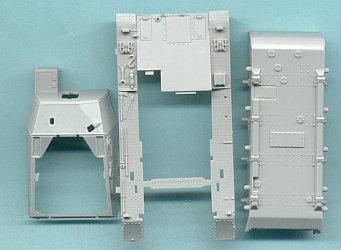
Above are the major hull parts. At far left is what the instructions refer to as the "turret" and I refer to as the superstructure; the overall shape looks accurate. Here we see the small
driver's compartment on the left side with overhead hatch molded closed, but no matching compartment on the right side of the gun. The weld beads are over exaggerated. In the roof are small
holes for the gun sight and scissors binoculars. On the right side were can make out the molded-on towing cable which I recommend cutting off and replacing for a display model.
In the center is the upper hull with a fine tread pattern on the mudguards. Molded-on tools are nicely done but still, some of them could have been molded as separate parts. The small
rectangular brake maintenance hatches have no vent holes and are flush with the glacis like with the Pz.IV Ausf. E.
At right is the slide-molded lower hull with detailed bottom and mounting points for the suspension bogies.
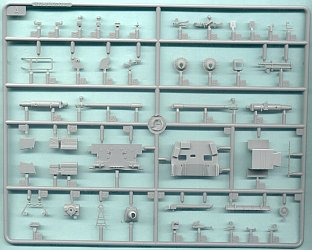
This is Sprue-A containing the 10.5-cm gun parts such as the two-part gun barrel (parts A21 through A24) and many interior parts. Left of center is the rear compartment plate (part A1)
with two small doors, which are unfortunately molded closed, but interior and exterior detail is good. There are ammunition bins included (parts A26 and A31) but unfortunately no loose
ammunition rounds (the ammunition came in two parts).
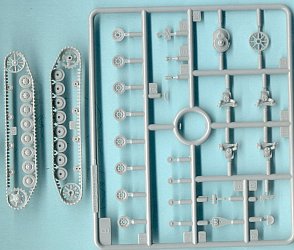
At left are the two track runs incorporating the track molded onto the outer sprocket, idler wheel, return rollers and road wheels. These delicate parts come protected in bubble wrap.
The slide-molded track actually looks very good and this method of doing track, previously seen on wargaming kits holds a lot of promise. It is certainly better than Hasegawa's 1/72
Pz.IV track and Revell's 1/72 StuG IV track. A few track guide teeth are missing by the sprockets and idler wheels but these can be scratch built. On the two Sprue-B, the inner wheels
are separate and also hold the bogie assemblies (part B1). Based on the style of wheels this panzerjäger appears to be based on the Pz.IV E variant or earlier.
Kit Assembly Instructions
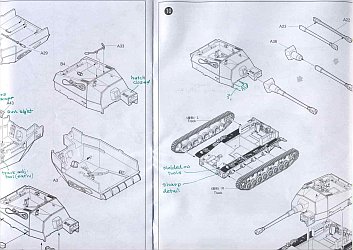
The instructions come in ten part exploded-view line drawings and appear clear and accurate. In Step 10 I have drawn in the missing box compartment to the right of the main gun.
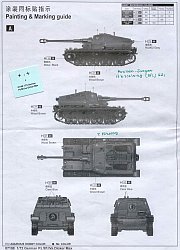
The last page of the instructions show the dark gray color and markings for one the 10cm K. Pz.Sfl.Iva. The small water-slide decal markings are at upper left for a vehicle of the Panzer
Jaeger Abteilung 521 (Tank Destroyer Battalion 521).
The overhead, right and front view finally show us the missing box-shaped compartment right of the gun barrel. This compartment has a smaller hatch than the driver's compartment with smaller
hinges and with no side visor, leading me to believe that it was a storage or engine access location, not a crew member compartment.
References
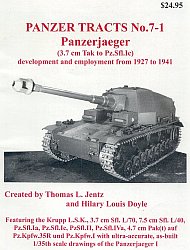 |
[1] Panzer Tracts No. 7-1 Panzerjaeger (3.7 cm Tak to Pz.Sfl.Ic.) development and employment from 1927 to 1941, Thomas L. Jentz and Hilary Louis Doyle,
Panzer Tracts, Boyds, MD 2004 ISBN: 978-0974486239
(This is the most complete and trustworthy reference I have yet found on the vehicle, with excellent history and historical photos.
On the book cover is an excellent front quarter view photograph showing the two box shaped compartments on each side of the gun. In photos of the vehicles serving in Russia they had a
gun travel lock, while this apparent factory photo shows the Dicker Max prior to adding the travel lock. In contrast to the Trumpeter kit, the superstructure's weld beads are nicely
finished and not very visible.
One of the authors, Tom Jentz, passed away this year and though I did not know him well I will miss him and his contribution to military history and to our hobby.) |
[2] Achtung Panzer!
[3] Encyclopedia of German Tanks of World War Two, Peter Chamberlain and Hilary Doyle, Arms & Armour Press, London 1978. ISBN 1-85409-518-8
Preview sample purchased by the author.
|
